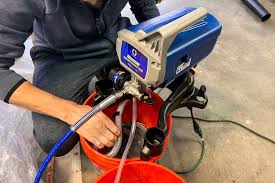When it comes to tackling home improvement projects or professional painting jobs, the paint sprayer has become an indispensable tool. Unlike traditional brushes and rollers, paint sprayers deliver a smooth, even coat in a fraction of the time. Whether you’re refreshing walls, staining a deck, or refinishing furniture, the right sprayer can transform the process.
In this guide, we’ll explore everything you need to know about paint sprayers—from their types and benefits to tips for achieving the perfect finish.
Why Use a Paint Sprayer?
Painting large or detailed surfaces can be time-consuming. A paint sprayer offers several advantages over traditional methods:
- Speed: Cover large areas quickly with minimal effort.
- Smooth finish: Eliminates brush marks and roller streaks.
- Versatility: Works with walls, ceilings, cabinets, fences, and furniture.
- Efficiency: Reduces wasted paint when used correctly.
For homeowners and professionals alike, paint sprayers are a practical investment that pays off in convenience and results.
Types of Paint Sprayers
1. Airless Paint Sprayers
These sprayers use high pressure to push paint through the nozzle, making them ideal for large projects such as walls, decks, and exterior surfaces. They’re powerful and fast but require careful handling to avoid overspray.
2. HVLP (High Volume Low Pressure) Sprayers
HVLP sprayers are perfect for detail work like cabinets, furniture, and trim. They deliver a fine, controlled spray with less overspray compared to airless models, making them popular among DIYers and professionals who value precision.
3. Pneumatic (Compressed Air) Sprayers
Using an air compressor, these sprayers provide a smooth, flawless finish. They’re commonly used in automotive painting and fine woodworking projects. However, they consume more paint and require a steady air supply.
Key Features to Look For in a Paint Sprayer
When shopping for the right model, consider these factors:
- Adjustable pressure settings for different materials and surfaces.
- Tip sizes to match various paint types (latex, stain, lacquer).
- Portability—lightweight, handheld models for small jobs, or larger wheeled units for big projects.
- Easy cleaning systems to save time after use.
Preparing for a Paint Sprayer Project
Proper preparation is crucial for a flawless finish. Here are a few steps:
- Clean the surface – Remove dirt, dust, and grease.
- Mask and cover – Use painter’s tape and drop cloths to protect trim, floors, and fixtures.
- Test spray pattern – Practice on cardboard or scrap material before starting.
- Wear safety gear – A mask, goggles, and gloves protect against fumes and overspray.
Best Practices for Using a Paint Sprayer
- Maintain consistent distance: Keep the sprayer about 10–12 inches from the surface.
- Use steady movement: Move horizontally or vertically in overlapping passes to avoid streaks.
- Thin paint if needed: Some sprayers require slightly thinned coatings for better flow.
- Clean immediately after use: Prevent clogs and extend the life of your equipment.
Common Mistakes to Avoid
- Spraying too close: Causes drips and uneven layers.
- Skipping prep work: Leads to poor adhesion and rough finishes.
- Ignoring maintenance: Clogged tips and dried paint can ruin results.
- Overlapping too much: Results in thick, uneven coats.
Paint Sprayers for Different Projects
For Home Interiors
An HVLP sprayer is ideal for painting walls, ceilings, and trim with minimal overspray indoors.
For Exteriors
An airless paint sprayer handles siding, fences, and decks with speed and coverage.
For Furniture and Crafts
Choose a small HVLP or pneumatic sprayer for precision and smooth finishes.
Cost Considerations: Is a Paint Sprayer Worth It?
While the upfront cost may seem high, paint sprayers often save money in the long run by reducing wasted paint and cutting down project time. Entry-level models are affordable for DIYers, while professionals can benefit from investing in heavy-duty systems.
Maintaining Your Paint Sprayer
Proper care extends the life of your sprayer.
- Flush the system with water or solvent after each use.
- Store in a clean, dry place.
- Replace worn tips and filters regularly.
- Lubricate moving parts as recommended by the manufacturer.
Choosing the Right Paint Sprayer for You
To select the best sprayer:
- Identify your project size (small furniture vs. large exterior walls).
- Consider the material you’ll be spraying (latex paint, stain, lacquer).
- Balance budget and features—don’t overspend on features you won’t use.
For detailed reviews and expert recommendations, resources like https://toolifyhome.com/ offer practical insights into different models and their performance in real-world applications.
Conclusion: Transform Your Painting Projects
A paint sprayer can take the hassle out of painting and help you achieve professional-looking results at home or on the job site. By understanding the types of sprayers, preparing your workspace, and following best practices, you’ll enjoy a faster, smoother, and more efficient painting experience.
Ready to take your projects to the next level? Explore your options, practice with your equipment, and soon you’ll wonder how you ever painted without a sprayer.

